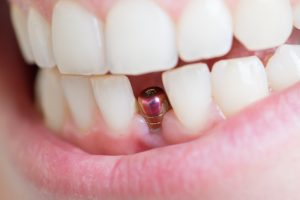A Dental Implant is an artificial tooth placed, specifically screwed, into the jaw of the patient to replace a previous tooth. Dental implant services are popular with people who may have a missing tooth possibly caused by several reasons such as accidents or perhaps a dental disease. Furthermore, a dental implant can be classified as a form of the dental prosthesis that should replace a missing tooth of a patient.

What Problems Does The Service Or Procedure Solve?
Being a type of dental prosthetics, dental implants aim to replace any missing tooth through a modern method called osseointegration. In the process of osseointegration, dentists make use of the biological properties of the human tissue and bone to bind with titanium and other materials used in for dental implants. The result of this process is the integration of implant and bone which then supports the prosthetic teeth in long periods of time.
Dental Implants would usually have two types or modes that clients could choose from namely Endosteal and Subperiosteal. Endosteal is the rather common type of implant used by many and would entail having screws and cylinders placed into the jawbone to hold the individual implant. The latter option, on the other hand, is called Subperiosteal which are dental implants placed on the jaw rather than in it. This type of implant is meant to be utilized by patients who are not fit to wear dentures due to bone height.
Steps Involved And The Description Of The Service Or Procedure
The basic implant surgery would usually entail five steps.
- Incision: This step is the first one of the five and would initiate the implant surgery by making a small incision over the crest of the bone where the gingiva is located. The attached gingiva will be sliced to make space for the penetration of the implant.
- Drilling: After making a small insition, the next step would be to drill the bone of the jaw precisely. Using precision drills, a small hole will be created and will be the site where the implant would be placed in the next step. The drilling process must be done with utmost accuracy and speed as the absence of both would cause burning and pressure in the area.
- Drilling (Slow): Once the initial fast drilling has been done to create a hole on the bone, the next phase would be to drill at a slow pace to create a bigger hole where the implant could finally fit properly
- Placement: As mentioned, the next step will be the placing of the implant and this process is done with the use of a torque controlled wrench. In this step, the implant screw or an analogue before it will simply be placed precisely into the hole created in the previous step.
- Tissue Adaptation: Once all the processes are done, the next step would be to put back the tissue to its initial position before it was sliced in half during the first step of the whole procedure.
Advantages Of The Service
Unlike the other forms of dental prosthesis, dental implants are known to be more secure and long-term than using regular dentures. As mentioned, the process of osseointegration is utilized when having dental implants and this should ensure you that your prosthetic teeth would stay where it should stay for a long time.

Furthermore, other effects of using dental implants are related to its overall goal of replacing a missing or rotten tooth. After having dental implants, expect to have improved comfort, speech, eating convenience, and more.
Risks Involved Or After Effects
According to Dr. Roman Fedorciw, a Middletown CT Dentist, the success of the process would depend on the health of the person undergoing the surgery where patients with better oral hygiene and healthy gums should fare better than those who do not. Much like any other surgeries, the process of dental implantation could suffer from the usual risks of infection, bleeding, nerve injuries, and more.
As for its effects after the procedure is done, usual concerns would be on the stability of the implant and the overall comfort of having the prosthetic teeth. These two concerns should be solved in due time without the need for another surgery if all goes well.
Finally, after everything has been set and all the complications have already been addressed, the last thing that you would need to do is, of course, to maintain it properly. Brushing your teeth and flossing should still be applied to the prosthetic teeth. On the more obvious side of things, make sure that you still maintain a good oral hygiene to avoid any more cases wherein you would need to undergo the same surgery again.
References:
smiledrs.com/dental-implants/
en.wikipedia.org/wiki/Dental_implant
perio.org/consumer/dental-implants


NICE POST THANKS